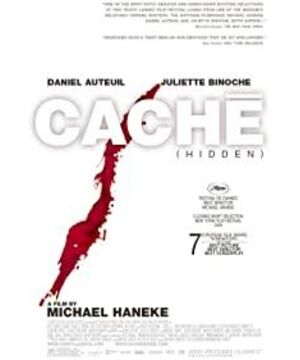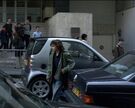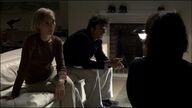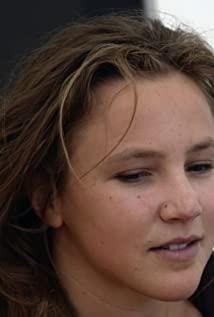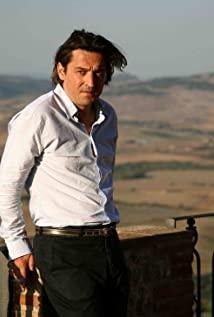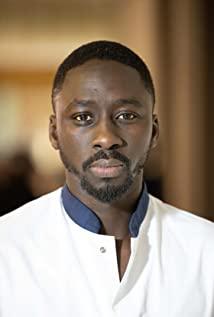Michael Haneke's brilliant point in "Candid Shooting" is that he did not reveal who was the one who placed the hidden camera. He used this suspenseful story as a guide, and he was more concerned about the individuals and families exposed during the story. and social and national issues. The protagonist Georges was initially reluctant to tell his friends and mother about the mysterious video tapes, and later even to his wife Anne (played by Juliette Binoche), refused to reveal his suspicions (Majid), and used lies to cover up his relationship with Majid. The fact that they were reunited in the apartment (until it was revealed that Georges hesitantly did not tell Anne all of his memories of falsely accusing Majid and devising a chicken-killing scheme 40 years ago). The movie "Cidden Shot" reflects the fragile relationship between people who conceal, deceive, or distrust each other. The wife Anne may have an affair behind her husband's back, and the son Pierrot hides from his parents and spends the night outside... For us audiences In other words, will the Majid father and son still suspect them after they have successively denied being involved in the mysterious videotape incident, or believe that they are the ones who hid the camera?
As a literary TV show host with both fame and fortune, Georges is undoubtedly a typical intellectual and a representative of the middle class. After he and his wife Anne walked out of the police station, they yelled at him because they were almost knocked down by a young black man. It shows the contradictions that still exist between different classes or different races in society. The Algerian immigrants represented by the Majid father and son, although there are a large number in France, are unable to integrate into mainstream society. Therefore, Georges as a child did everything possible to prevent Majid from becoming a full member of his family. It seems to imply racial discrimination and social resistance, It makes it difficult for these immigrant descendants who are being marginalized to have a chance to go up. When Majid brought Georges into his room for the second time and killed himself by slitting his throat before we could react, a blood splattered on the wall seemed to be a sobering accusation for the audience; Discrimination and hatred can lead to cruel and bloody things, just like the current conflict between "Islamic State" and Western countries, which has caused more serious damage to many families.
Michael Haneke's "Sneak Shot" not only reveals the hypocrisy of the erudite intellectuals with countless books and the middle class, but also the hypocrisy of the civilized world; the seemingly insignificant news clips he inserted into the film can also insinuate Some Western democracies have invaded the territories of other countries under the banner of so-called rescue. There is also the 1961 crackdown mentioned in Candid Photography, when thousands of Algerian immigrants were brutally suppressed by the French police in order to protest the French government's "curfew" and support Algeria's independence movement ( Majid's parents were also killed in the Seine along with hundreds of other compatriots), but it was not until 2012 that then French President Francois Hollande admitted the atrocities in the name of the country, breaking France's 51-year silence on this historical event (At the time of the film's release, the French government still did not admit that they had committed violence against the population). From this, it can be seen that the film "Silent" elevates the concealment and deception between people to the "national level". In the penultimate act, the image of the young Majid being captured by the staff of the orphanage is also similar to It is reminiscent of scenes of power and state machinery to suppress Algerian immigrants.
Michael Haneke's "Elaborately Planned" "Sneak Shot" is full of uncertainties, such as whether the Majid father and son must be "behind the scenes", or whether through ambiguous shots, the audience will feel that Anne never stole from others What about love? This world is both true and false, and sometimes false and true. The director deliberately interspersed the hidden camera and the real picture with each other, which further strengthened this uncertainty and made the audience gradually begin to doubt that the image in front of him is a plot. Is it really going on, or is the protagonist watching the videotape. And this hides the lens behind it, and constructs our cognition and symbolizes our subjectivity. Everyone has a subjective lens in his heart, and is at the mercy of it, dominated by it, and always from his own perspective and point of view. Criticize those who are "not pleasing to the eye". Georges, who is also a TV show host and producer, does not want to be manipulated (in fact, he always follows the location where the videotape appears), and on the other hand, relies on his subjective judgment to decide and edit. The interview can be done. The "Out of the Street" clip; or including director Michael Haneke himself, also likes to manipulate the audience. From the beginning, the seemingly objective and calm picture appears, leading everyone to sympathize with the Georges family's experience.
The movie "Sneak Shot" uses a lot of long shots to present people's lives as if they were being watched. When Georges returned home from the police station after his son Pierrot disappeared, a filmed him from a normal expression until he suddenly walked into the kitchen. The long shot of crying can't help but let us see the whole process of his inner collapse; and the part of Majid's son following Georges into the elevator is also a well-designed continuous record, showing that he is left and right in the elevator screen. The two of them, in an atmosphere of mutual opposition and unease. "Candid Shooting" does not use any soundtrack, but it highlights the expressiveness of the camera. Although the penultimate scene of the film was shot in sunny weather, it has a deep sense of coldness and silence. Running away, it happens to be the contrast between the bright and the cold, the static and the dynamic, and this long shot from the third vision, it may be everything that Georges stole as a child, or the image he dreamed in his sleep, or it may be In order to echo the beginning, the director deliberately reminded everyone that there is a hidden camera in the distance of Georges' hometown.
Many viewers and commentators will think that the person who placed the hidden camera is Michael Haneke himself. At the end of the film, he "suddenly filmed" Pierrot's school gate. At this time, the same fixed shot was captured in the bustling environment. The penultimate act, as well as the feeling of coldness and alienation in the previous pictures, was not handled. In the lower left of the camera, there is a dialogue between the son of Majid and Pierrot. As Michael Haneke once said, "I hope the next generation can have a dialogue"! But he silenced the passage, leaving a lot of space for the audience to think about. One of the amazing things about this film is that it uses long shots to emphasize the so-called sense of reality or documentary, and at the same time raises the question of whether what we see is equal to all the facts, even though everyone is captured by many surveillance cameras every day , However, behind these "hidden cameras", the secrets and truths hidden, I am afraid, only the parties and God can fully know.
View more about Caché (Hidden) reviews


